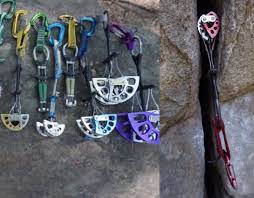Introduction
Rock climbing is a thrilling and challenging sport that requires skill, strategy, and above all, safety. Protecting yourself on the rock is of utmost importance, and that’s where climbing protection devices come into play. In this comprehensive guide, we will delve into the world of rock climbing protection, exploring the difference between passive and active protection devices. From nuts and hexcentrics to spring-loaded camming devices, we’ll equip you with the knowledge to confidently tackle any climb with the right gear.
- The Difference Between Passive Protection and Active Protection
Passive Protection: Passive protection devices are non-mechanical and rely on their shape and placement to secure themselves within rock cracks or fissures. They are simple, reliable, and don’t require any moving parts. Passive protection includes nuts, hexcentrics, and tricams.
Active Protection: Active protection devices are mechanical and use springs or cams to expand within rock cracks, creating a secure anchor. They can be easily placed and removed, making them a favorite among climbers. Active protection includes spring-loaded camming devices (SLCDs).
- The Different Types of Passive Protection Devices
a) Nuts: Nuts, also known as wired nuts or chocks, are metal wedges attached to a wire cable. They are designed to fit into various crack sizes and provide solid placements. Nuts are lightweight and versatile, making them an essential component of any climber’s rack.
b) Hexcentrics: Hexcentrics, or hexes, are hexagonal-shaped passive protection devices. They offer excellent stability in larger cracks and are popular for traditional climbing routes. Hexes come in different sizes and can be placed in camming or non-camming positions.
c) Tricams: Tricams, short for tricamming devices, are hybrid protection devices that can be used as both passive and active protection. They have a camming head that can be placed in a camming position and a passive nut-like head for wedging in cracks.
- The Different Types of Active Protection Devices
Spring-Loaded Camming Devices (SLCDs): SLCDs, commonly known as cams, are the most widely used active protection devices. They consist of multiple spring-loaded lobes that retract when not in use and expand to create a secure placement within rock cracks. Cams offer quick and efficient protection and are especially useful in parallel-sided cracks.
- The Right Gear for the Right Situation
- Passive Protection: Nuts, hexcentrics, and tricams excel in placements where the crack geometry allows for solid wedging. They are also preferred in situations where you need a quick and simple protection option.
- Active Protection: SLCDs are versatile and excel in situations with parallel-sided cracks, where they can be easily adjusted to fit the crack size. They are highly efficient in providing secure placements in various rock types.
FAQs – Your Rock Climbing Protection Questions Answered
- Can I mix passive and active protection on the same climb?
Yes, it is common to use a combination of passive and active protection on a single climb. The choice of protection depends on the crack size and geometry, as well as personal preference and familiarity with the gear.
- Are passive protection devices more reliable than active ones?
Both passive and active protection devices are reliable when used correctly. The reliability of any protection device depends on the quality of placement, rock type, and the forces applied during a fall.
- How many protection devices should I carry for a climb?
The number of protection devices you’ll need depends on the length and difficulty of the climb, as well as the spacing of available placements. Carry a variety of gear to ensure you have the right size for different cracks.
- Can I use passive protection in flaring cracks?
Passive protection can work in flaring cracks but may not provide as secure placements as active protection in such situations. Experiment with different gear placements to find the most stable option.
Conclusion
As you venture into the vertical world of rock climbing, understanding the difference between passive and active protection devices is crucial for your safety and success. Passive protection devices like nuts, hexcentrics, and tricams offer simplicity and versatility, while spring-loaded camming devices (SLCDs) provide efficiency and ease of use. As you build your climbing experience, experiment with various protection devices to understand their strengths and limitations in different rock formations. So, gear up with the right protection, embrace the challenge, and experience the exhilaration of rock climbing like never before! Happy climbing!
